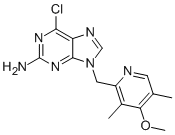All AbMole products are for research use only, cannot be used for human consumption.

BIIB021 (CNF2024) is an orally available synthetic non-ansamycin Hsp90 inhibitor with ki value of 1.7nM. BIIB021 (CNF2024) selectively and potently inhibits the molecular chaperone Hsp90 thereby inhibiting the proper assembly of multiple oncogenic proteins involved in tumor growth and survival.BIIB021 (CNF2024) has antitumor activity in Hodgkin's lymphoma in vitro and in vivo. BIIB021 (CNF2024) selectively induced Hodgkin's lymphoma cell death but did not kill normal lymphocytes from healthy individuals. BIIB021 inhibited the activity of NF-κB, which was independent of IκB mutations.
| Cell Experiment | |
|---|---|
| Cell lines | N87, MCF-7 and BT474 cell lines |
| Preparation method | Cell Proliferation Assay. A modified tetrazolium salt assay was used to measure the inhibition of tumor cell growth. Cells were added to 96-well plates and propagated for 24 h before compound addition. The compound was serially diluted and added at a concentration range of 3 to 1,000 nmol/L to the plated cells. DMSO (0.03-0.003%) was included as a vehicle control. Cells were incubated in the presence of compound for 5 days. After incubation phenazine methosulfate (stock concentration 1 mg/mL) and 3-(4,5-dimethylthiazol-2-yl)-5-(3-carboxymethoxyphenyl)-2-(4-sulfophenyl)-2H-tetrazolium, inner salt (stock concentration 2 mg/mL; Promega) were mixed at a ratio of 1:20 and added to each well of a 96-well plate. Reduction of 3-(4,5-dimethylthiazol-2-yl)-5-(3-carboxymethoxyphenyl)-2-(4-sulfophenyl)-2H-tetrazolium, inner salt gave rise to a soluble formazan product that was secreted into the culture medium. After 4 h incubation, the formazan product was quantitated spectrophotometrically at a wavelength of 490 nm. Data were acquired using SOFTmaxPRO software, and 100% viability was defined as the A490 of DMSO-treated cells stained with 3-(4,5-dimethylthiazol-2-yl)-5-(3-carboxymethoxyphenyl)-2-(4-sulfophenyl)-2H-tetrazolium, inner salt (the mean A490 of cells treated with DMSO at a range of 0.03-0.003%). Percent viability of each sample was calculated from the A490 values as follows: % viability = (A490 nm sample / A490 nm DMSO-treated cells × 100). The IC50 was defined as the concentration that gave rise to 50% inhibition of cell viability. |
| Concentrations | 3 ~ 1000 nM |
| Incubation time | 5 days |
| Animal Experiment | |
|---|---|
| Animal models | nude mice bearing N87 stomach carcinoma tumors xenograft model |
| Formulation | |
| Dosages | 31, 62.5, and 125 mg/kg, once daily, from Monday to Friday, for 5 weeks |
| Administration | orally |
| Molecular Weight | 318.76 |
| Formula | C14H15ClN6O |
| CAS Number | 848695-25-0 |
| Solubility (25°C) | DMSO 60 mg/mL |
| Storage |
Powder -20°C 3 years ; 4°C 2 years In solvent -80°C 6 months ; -20°C 1 month |
| Related HSP Products |
|---|
| Potassium palmitate-13C16
Potassium palmitate-13C16 can induce the expression of glucose-regulated protein 78 (GRP78) and CCAAT/enhancer binding protein homologous protein (CHOP) in in mouse granulosa cells. |
| NCT-58
NCT-58 is a potent inhibitor of C-terminal HSP90. |
| Gedunin
Gedunin is a limonoid with anti-cancer, anti-viral, anti-inflammatory and insecticidal activities. |
| VER-49009
VER-49009 is a Hsp90 inhibitor, with an IC50 of 25 nM and a Kd of 78 nM. |
| YUM70
YUM70 is a potent and selective inhibitor of glucose-regulated protein 78 (GRP78), with an IC50 of 1.5 μM for inhibiting GRP78 ATPase activity. YUM70 induces endoplasmic reticulum stress-mediated apoptosis in pancreatic cancer. |
All AbMole products are for research use only, cannot be used for human consumption or veterinary use. We do not provide products or services to individuals. Please comply with the intended use and do not use AbMole products for any other purpose.


Products are for research use only. Not for human use. We do not sell to patients.
© Copyright 2010-2024 AbMole BioScience. All Rights Reserved.
